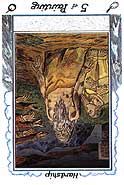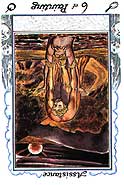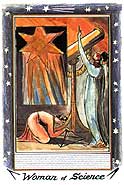what if I just stay put?
| The Three Fates spread is an exceptionally popular way to gain insight into the emerging arc of the past, present, and future. The William Blake Tarot explores the mystical vision and artistry of the renowned English painter and poet. Through rich interpretations focused on creative undertakings, it has long been the deck of choice for artists, writers, musicians, and thinkers. For more information about this deck, or to buy your own personal copy, go to www.blaketarot.com.
|
 | The left card represents an important element of the past. Five of Painting (Hardship), when reversed: Transcending difficulties, insecurity, and financial worries. Taking responsibility for ones own actions or mistakes. Stripping down for action. Facing up to your fears and critics. Issues of support, loyalty, or companionship in hard times. In the creative process: Realize that the problems you are trying to solve may put you at odds with others who do not recognize your value. Be ready to grapple with personal blocks and fears, and to hear more from your inner voice than reasons why things won't work. |
 | The middle card represents a deciding element of the present. Six of Painting (Assistance), when reversed: Reliance on favors or tangible help of some kind. Restrictive influences from sponsorship or patronage. A negative influence in the situation. Being "kept". The illusion of generosity. Charity with strings attached. Taking advantage of those in need. In the creative process: You can attract the assistance and tools you need by using your imagination and not giving up hope. |
 | The right card represents a critical element of the future. Woman of Science: Seeking out pertinent data. Methodical approach to a problem. Looking within yourself for answers. Upholding truth. Counseling others. Forming opinions based on observation and deduction. Weighing abstract ideas. Avoiding personal involvement. Demonstrating principles. Self-discipline. Be cautious of becoming opinionated or over-professional. In the creative process: Now is the time to research and gather information, get an overview, and make long-range plans and strategies. |
|
|





